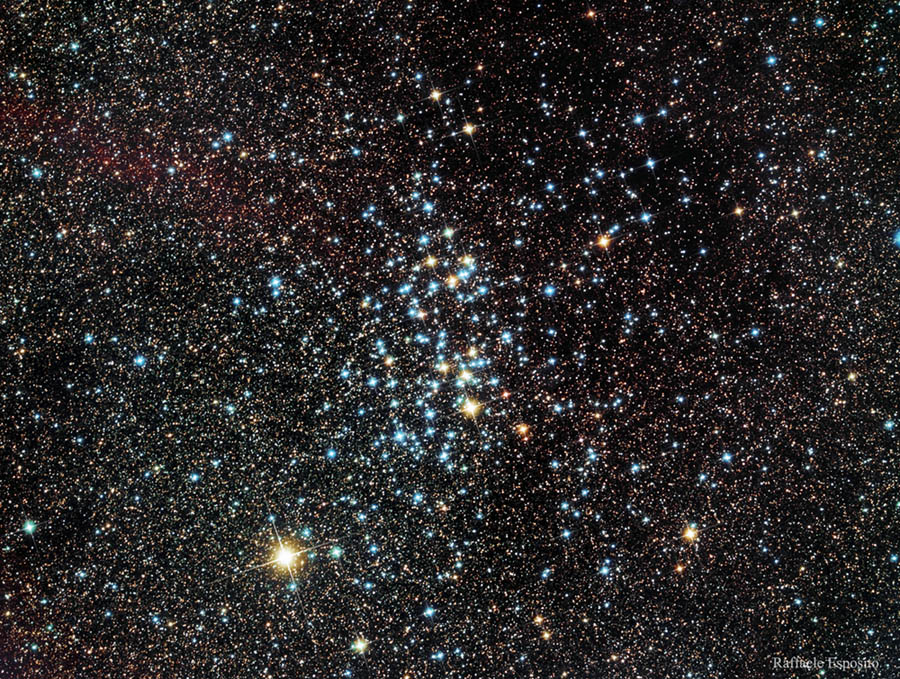The southern constellation Carina contains arguably the best nebula in the sky, along with a host of other fascinating stars and clusters.

IAU / Sky & Telescope (Roger Sinnott & Rick Fienberg)
High in the south at this time of year is one of the brightest stellar beacons in the whole sky — Canopus, or Alpha (α) Carinae. Impossible to see from most of North America due to its far southerly declination (−52° 42′), the brightest star of the constellation Carina, the Keel, is nonetheless a friendly sight for south-of-the-equator stargazers. Blazing at apparent magnitude –0.74, it’s second only to Sirius (–1.46) in brightness.
Although spectrally classified as blue-white star, to my eye Canopus has a slightly yellowish cast. It’s huge, more than 70 times wider and thousands of times brighter than our Sun, and with around eight times the Sun’s mass. It’s nearby, too — just 310 light-years away. No wonder it shines so prominently.
Canopus’s is joined by several other fine sights in Carina for the naked-eye observer. Prime among them is the huge Carina Nebula (NGC 3372) as well as the open star clusters NGC 3532 and IC 2602, each located at the opposite end of the constellation from Canopus.
Carina Nebula

Amirreza Kamkar / S&T Online Photo Gallery
If the Carina Nebula were located in the northern part of the sky, where more observers could see it, it would probably be the most famous nebula of them all. Because even though it is around six times farther away than the Orion Nebula — 8,500 light-years as opposed to Orion’s 1,340 light-years — it is much brighter and covers four times the area on the sky.
The Carina Nebula is actually a collection of bright and dark nebulae along with associated star clusters. Famous constituent nebulae include the Homunculus Nebula and the Keyhole Nebula.
Embedded within the complex is the star Eta (η) Carinae, a hypergiant more than 100 times the mass of the Sun and around 4 or 5 million times brighter. Eta Carinae is actually a two-star system, currently at 4th magnitude, though it has undergone several large brightness increases in recent centuries. In fact, in the 1830s and 1840s, it brightened so much that it outshone Rigel and Alpha Centauri! That almost 20-year-long period that came to be known as the “Great Eruption.” It subsequently faded, before once again brightening in the last decade of the 19th century, this time reaching 6th magnitude.
But that’s not all. After levelling off at around 6th to 7th magnitude for most of the 20th century, it began to very slowly increase in brightness until suddenly, in 1998–99, it doubled in brightness and once again became bright enough to be visible to the naked eye. So it’s worth keeping an eye on this star, for who knows? — you could be the one to spot the beginning of its next rise to greatness.
Clusters and Stars

Raffaele Esposito / S&T Online Photo Gallery
Only 3° west-northwest of the Carina Nebula is NGC 3532, a group of about 150 stars around 1,300 light-years from Earth. Aside from its magnificent appearance, the cluster has the distinction of being the first target chosen for the purpose of focusing the Hubble Space Telescope after it was launched in 1990. Also known as Caldwell 91, NGC 3532 is easy to discern as a fuzzy, third-magnitude blob mixed in with the rest of the Milky Way’s glow. A small telescope begins to reveal individual stars.
Slightly more than 6° to the south-southeast is another fine open cluster IC 2602.While having only half as many stars at NGC 3532, IC 2602 is even more prominent at magnitude 1.9 and, arguably, is even more glorious. This cluster is the third brightest in the sky, behind the Hyades and the Pleiades. Located at a distance of about 480 light-years, it’s the fourth-closest star cluster to our solar system. Its proximity has led to its prominence and has helped it to become known as the “Southern Pleiades.”

Fernando Menezes / S&T Online Photo Gallery
A third, easy-to-spot open cluster in Carina is NGC 2516, also known as the Southern Beehive. To the unaided eye, it appears as a fuzzy patch about 30 arcminutes across. Binoculars easily resolve its individual stars.
Our final Carina highlight is its second-brightest star, Miaplacidus (β Car), an A-class star with a visual magnitude of 1.69, making it the 28th brightest star in the night sky. It’s a close one too — only around 113 light-years away.
The origin of its name is interesting — it seems to be a curious combination of the Arabic word miyāh (“waters”) and the Latin word placidus (“placid”). The aquatic theme is fitting given that Carina, the Keel, was once part of a larger constellation: Argo Navis, the ship of Jason and the Argonauts. The mythical Jason had anything but a placid life — after all sorts of dangerous adventures, he ended up being crushed by his own rotting ship. Fortunately for us, stargazing is a very peaceful and enjoyable endeavour, and all the more so when you have endless interstellar wonders to savor, such as those found in Carina.
 8
8








